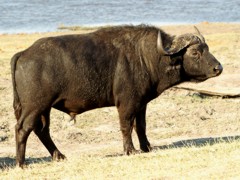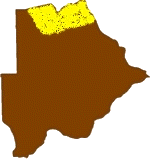Buffalo - Syncerus caffer
also known as Cape or African Buffalo, German: Buffel; French: Le Buffle d'Afrique
Spanish: Bufalo, Italian: Bufalo; Polish: Bawol; Setswana: Nare
Photo 1 - jpeg
What is it?
A bovine (cow-like) mammal. (Other bovines include antelopes, sheep and goats).
Characteristics
Adults thickset, dark brownish-black; juveniles lighter brown.
Shoulder height 140 cm. Bulls massive, up to 800 kg in weight, with heavy, deeply curved horns which meet at the top of the head forming a kind of helmet known as a “boss”. Cows (550 kg) with more slender horns and no boss. Large ears droop beneath the horns. Relatively short, thick legs and large hooves. Dung very similar to cow pats.
Gestation 11 months. 1 calf born between October and April (coinciding with the rainy season).
Photo 2
Photo 3
Photo 3
Distribution: Okavango Delta, Moremi Game Reserve, Chobe National Park, Chobe River front, Linyanti and Kwando areas, Northern safari and hunting concessions.
Status in Botswana: Numbers dramatically declining in the last decades, large herds still occur in the Northern wildlife areas of Botswana. Hunted.
Habitat: Found in a wide variety of vegetation types. Usually in open plains or floodplains, at night and in the cooler parts of the day, seeking woodland shade in the heat of the day.
Best places to see: Chobe River front, Kwando and Linyanti areas, Chief's Island and Mombo area in Moremi Game Reserve, other areas in Moremi Game Reserve, Khwai River area, Okavango Delta.
Diet
Mostly grasses; also some leaves of shrubs and trees. Buffaloes are water dependent and usually drink once a day, early in the morning or in the late afternoon.
Longevity
20 – 25 years.
Notes
May be seen in large herds (of several hundreds to over a thousand) in the Okavango Delta’s floodplains and along the Chobe River, including Sedudu Island where herds may spend several consecutive days (despite the lack of shade), attracted there by the relatively lush grass and the decreased predation by lions.
They constitute one of the main prey species of lions in the Okavango Delta, Moremi Game Reserve and northern Chobe National Park, providing food for a pride for several days. Sometimes a group of buffaloes, usually bulls, will charge back at and rout attacking lions. In the late 1990s there was a formidable group of 10 bulls living near Sedudu Island that appeared to treat the resident lions with disdain, forming a compact, menacing and seemingly impenetrable cohort as they moved around in the area.
Buffalo herds often aggregate in the rainy season when food resources are abundant and fragment into smaller herds in the dry season when these resources are more limited. When a large herd is on the move, adult bulls typically take up rearguard and flank positions (from where danger usually comes). Often a cow assumes the leading position.
Buffaloes communicate vocally with cow-like bellows and lowing. In dry conditions the movement of a large herd can be detected two or more km away from the copious dust raised by its passage.
Warning
One of the famous (or perhaps notorious) “Big Five”. A potentially dangerous animal and these animals (bulls in particular, whether solitary or in small bachelor groups), should be given a wide berth by hikers on foot. Unlike elephants or lions, buffaloes are not given to “mock charging”, and if they come for you, they mean serious business. In a safari vehicle you are safe. Do not leave the safari vehicles to get better pictures of these animals. Several accidents are recorded provoked in this way by irresponsible tourists.


page and site still under construction
All rights reserved. Copy rights (design, images, text and graphics) by Marek Marciniak, Richard Randall - 2007